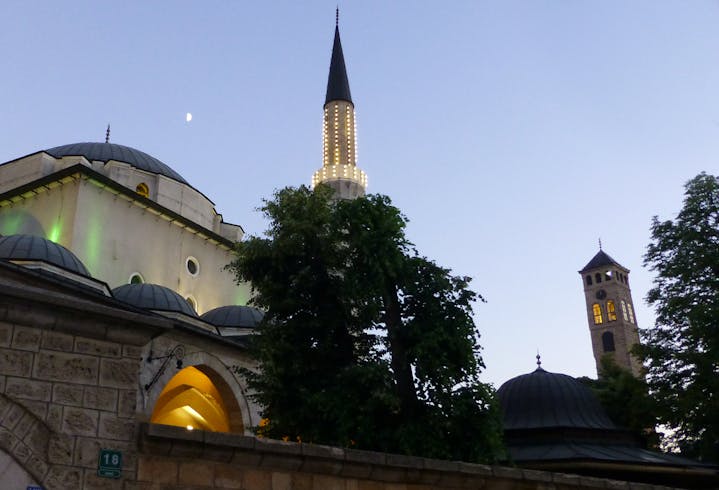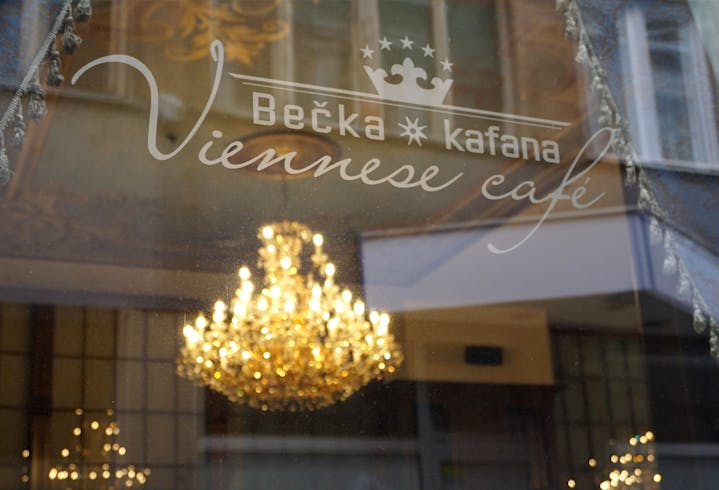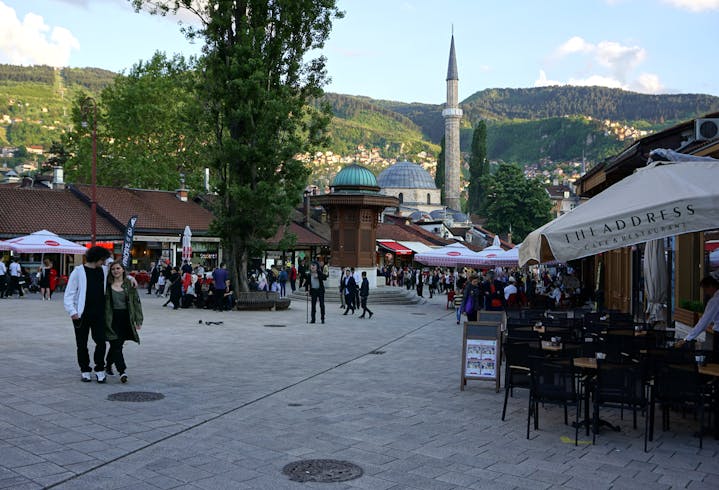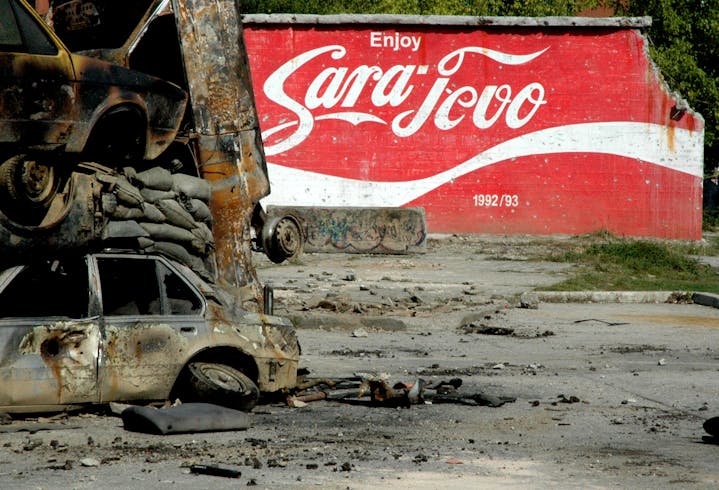Sarajevo - the Jerusalem of Europe
Sarajevo is sometimes called «The Jerusalem of Europe» or «Little Jerusalem». In fact, all monotheistic religions have peacefully divided this city for centuries. Muslims, Orthodox and Catholic Christians were already there when the city was founded in the 15th century. A little later, Sephardic Jews who fled the Spanish Inquisition came along.

House fronts on the banks of the Miljacka | Photo Mehmet Ozuryan, Shutterstock
Even if the view of this multi-religious city should be a bit glorified - if you walk through today's Sarajevo, you really notice that mosques, Orthodox and Catholic churches, and synagogues alternate. Apparently, they managed to live in peace with one another or at least next to one another for a long time, even if one believed in the same God in very different ways.

At first glance, it looks like the neighborhood of Islam and Christianity. But both structures are Ottoman. On the left the minaret of the Gazi Husrev Beg Mosque and on the right the clock tower, the Sahat Kula, which is often found in this form next to mosques and is built in the style of an Italian campanile.
That is why it is incredibly bitter that Sarajevo of all places had to experience how ethnic groups can be turned against each other until they attack each other with weapons. It resulted in a senseless war that meant almost four years of siege for Sarajevo. The ground for this war was prepared by nationalists of all camps through a policy of exclusion and hatred.
And let's not fool ourselves: Even in Central Europe today, right-wing nationalist ideas are widespread. Politicians who focus on division knowingly play with the risk of social and ethnic conflict. Right-wing populists and their enablers are already in power in a number of countries, including in Austria.

In the center of Sarajevo
Sarajevo's legendary openness must also have something to do with its location. Sarajevo has one foot in the Occident and the other in the Orient. You can drink the coffee either in the Turkish café or in the Austrian coffee house. In the same street, the architecture of the houses changes from Ottoman to western and back again.

There is a real Viennese coffee house in the Hotel Europa
The Bosnian writer Dževad Karahasan calls Sarajevo the «ideal city». Ethnically very distinct districts have formed there, Muslim, Orthodox, Catholic and Jewish, he writes. But this was understood as extended privacy. Then everything mixed up in public life. There, too, one could identify oneself as a Jew, Christian or Muslim in clothing and demeanor, but not with the claim to belong to the only true religion. There was no dominant culture or religion in public space.
In Catholic Bregenz, for example, a city where one religion or denomination traditionally dominates, the Protestant church stands outside the center and far removed from the street. That was the rule. Anything that was not Catholic had to be kept apart. Something like that is unthinkable for Sarajevo. Mosques and churches are sometimes almost wall to wall.

The Baščaršija, Sarajevo's «bazaar» in the old town.
So it was – at least in certain educational classes – quite common to invite friends and neighbors who did not share the same faith to break the fast, to Christmas or to the Feast of Tabernacles. This is what our friends in Goražde tell us too. They remember that in their childhood, they participated in many festivals and barely knew what was being celebrated.

The Franciscan Church of St. Anthony of Padua and in front of that the Sarajevska Pivara Brewery | Photo Jane Sweeney, Alamy
Here, it is fitting to briefly tell about the Franciscans in Sarajevo.
In Sarajevo, the Franciscan Church is built in the same style, and painted in the same red color, as the brewery next to it. It's not a coincidence. First, the Franciscans have always had an affinity for brewing beer. Second, they have had an incredibly long presence in Bosnia. They settled in Srebrenica in 1291 just 65 years after the death of Francis of Assisi. They have cleverly come to terms with those in power. When the Ottomans conquered Bosnia, Sultan Khan granted the Franciscans extensive protection and freedom of religion.
So the Franciscans brew beer in a city with a large Muslim population. During the war, however, the brewery made a major contribution to alleviating the plight of the trapped population. When the city ran out of water, the brewery quickly installed a number of water fountains on its outer walls. So you could tap drinking water at the brewery at night, but even there, of course, at great risk.
After the war, the Franciscan Ivo Marković founded a choir called «Pontanima» - Bridge of the Soul - to which Christians, Muslims, Jews and atheists belong. They sing songs in Hebrew, Arabic, Bosnian, Old Church Slavonic, Latin and Ladino, the language of the Sephardic Jews. Even if such traditions have decreased significantly after the war, there are quite a few people who want to revive the open spirit of Sarajevo.

View from the hills over the city
As we have seen, it is hard to talk about today’s Sarajevo without talking about the war. The siege was traumatic for Sarajevo. If you look over the city, you can see how wonderfully Sarajevo is nestled in the valley of the Miljacka, in the protection of the surrounding hills. In the logic of war, this is reversed: The city is completely unprotected, at the mercy of the besiegers after they have positioned their grenade launchers and snipers.

Sarajevans seek protection behind a UN armored personnel carrier | Photo Justin Leighton, Alamy
In April 1992, Bosnian Serb armed forces surrounded Sarajevo. A siege began that would last 1425 days, the 20th century’s longest siege, an hour's flight from Vienna. It is said that the Serbs did not let a bird into the city. The everyday life of the residents is unimaginable. Almost every street from the hills can be seen by snipers and the shell fire terrorizes trapped residents day and night. And yet there are incredible examples of civil society resilience in this threatened city. Two are briefly mentioned here.

The destroyed skyscraper of the daily newspaper Oslobodenje | Photo Johnny Saunderson, Alamy
«Oslobođenje» («Liberation») is a left-liberal Bosnian daily newspaper. Just a few months after the siege began, in July 1992, the editorial building was completely destroyed. The editorial team, which has always been multiethnic and made up of Bosnians, Serbs and Croats, decides to continue their work in air raid shelters. Helpers build an emergency power generator out of old Lada engines, with which the 75-member team can continue to produce their newspaper on a makeshift basis. Despite the siege, they continue to publish the newspaper. The editors make their way to the editorial office at risk of death because they have to cross the «Snajperska aleja» (sniper avenue), which is considered particularly dangerous. Some colleagues die on the way to work. When the distribution channels outside the city are interrupted, the Oslobođenje people cut up their newspapers and fax them to cities like Mostar and Srebrenica.
The newspaper received the European Parliament's Sakharov Prize after the war.

Black humor - a wall painting in Sarajevo | Photo Fabri, 123rf
The writer Safet Plakalo founded the «Sarajevo War Theater» just one month after the start of the war. He is a recognized playwright (and Ibsen Prize winner), but in a context of immense suffering in his city, he decides to only write comedies in the future. The ensemble is made up of actors from theaters that have already been closed due to the war. They play in a basement where visitors crowd every evening. In the winter, they bring some firewood for heating as price of admission. Time and again, it is reported, the miracle succeeds in making people laugh in the midst of the horrors of war. Not infrequently, however, the hunger for a bit of culture ends with death on the way home. The theater of war no longer wants to bear this responsibility. So it sets off on its own, goes to meet its audience and from begins playing in different parts of the city in cellars and garages, in bunkers, hospitals and children's homes.
Of course, we know that the situation in Sarajevo and Bosnia then as now is very complex and at times depressing. But we like to stick to such hopeful stories.

A café in today's Sarajevo